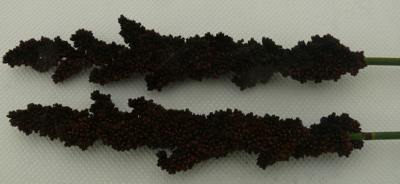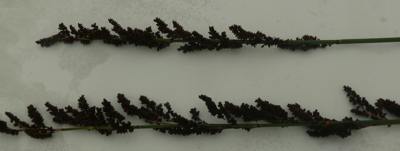Elegia aggregata
Elegia aggregata (Mast.) Moline & H.P.Linder
Family: Restionaceae
Common names: Hermanus riet (Afr.)
Introduction
Elegia aggregata is a tufted plant with attractive smooth stems. The stems are blue-green with dark brown inflorescences. This plant can be used in landscaping as it makes a good garden subject in garden beds or containers.

Description
Description
Elegia aggregata can grow up to 2m tall. The rhizomes of this plant are very short and culms are unbranched and round. The Restionaceae family typically have leaves in sheaths along stems (culms). Elegia aggregata has blue-green stems with dark brown sheaths that drop off, leaving behind circular rings known as abscission rings.

Male and female flowers are borne on separate plants. Male flowers produce pollen which attracts bees, although they are not pollinators of this plant, and female flowers produce seeds. Seeds are fine and dark, and are produced in December to January. Elegia aggregata is one of the fastest growing plants in the Restionaceae.
Conservation Status
Status
Elegia aggregata is Red Listed as Least Concern in the Red List of South African Plants.
Distribution and habitat
Distribution description
The natural distribution of Elegia aggregata is on the mountains of the Western Cape in Cape Town, and from Worcester to George. It grows among rocks and prefers well-drained soils. It is a moisture-loving plant but it will also do well in seasonally dry conditions. It grows in poor soils and in full sun and is suitable for coastal garden conditions.
Derivation of name and historical aspects
History
The family Restionaceae, commonly known as restios, is found on all southern continents. Restionaceae consist of approximately 357 species in Africa alone with about 300 of these species endemic to the Cape Floristic region.
Elegia aggregata was previously known as Chondropetalum aggregatum. The genus name Elegia comes from the Greek word elegos which means 'song of lamentation', as in the English word elegy. This may refer to the sound restios make while they are moving in the breeze. The specific name aggregata is Latin meaning clustered, and refers to the tightly aggregated female spikelets.

Elegia aggregata is similar to Elegia ebracteata, but the flowers of E. aggregata are bigger and the spikelets have more flowers compared to E. ebracteata .
Ecology
Ecology
All restios are wind-pollinated. The pollen is released by male plants and carried by the wind to female plants, where pollination takes place. Unlike other fynbos plants, like ericas and proteas, insects (pollinators) play no role in pollination activities.

When seeds are ripe, the capsule or seed pod splits open and the tiny dark seeds are released from December to January. Seed are released before the next group of flowers flower.
Uses
Use
Elegia aggregata is suitable for growing in containers and it makes a good garden subject. The blue-green coloured stems are exceptional especially when contrasted with small-leaved plants like ericas.

Growing Elegia aggregata
Grow
There are two commonly used propagation methods for this plant: sowing seeds and dividing rhizomes. Make sure you do not disturb the roots too much. Restio roots, like any other fynbos plant, are very sensitive. You need to be careful that they are not damaged. Divide rhizomes early in winter before the new culms arise from the rhizomes. Keep the plants in light shade and water them very well. Feed the plant every second week with organic fertilizer to encourage fast growth and the production of new culms.
The ideal time to sow seeds is in autumn (April-May) when day and night temperatures fluctuate between 22 and 10 degrees Celsius. Soak seeds for 24 hours prior to sowing. Use a mixture of milled bark and sand (fynbos mixture). Sow seeds in trays with the fynbos mixture and cover them lightly with sand. Sand, instead of milled bark, is preferred for covering seeds, as they are very tiny.
Seeds can be treated with smoke to stimulate germination. At Kirstenbosch National Botanical Gardens fynbos material is burnt in an enclosed container and the smoke is channelled into a tent filled with seedling trays. Use a tent to lay seedling trays out and then allow smoke to settle in. After an hour, move the trays out and house them in a well-ventilated area. Elegia aggregata germinates after 4 to 6 weeks. The smoke from the fynbos material produces a chemical cue that breaks the dormancy of seeds. Alternatively, treat seeds prior to sowing by using instant smoke primer.
Trays must be kept moist, but not wet, as that can cause seeds and seedlings to rot (damping-off). This is a common disease in restio seedlings. Prevent this by spraying with fungicides every two weeks after seedlings have emerged. Generally, restios are disease resistant once they pass the seedling stage. They only need sufficient water.
After germination, seedlings must be planted into plug trays to allow them to form a root ball so that they can grow stronger. Feed them with organic fertilizer to encourage growth. After 6 months, individual seedlings must be transplanted into 1 kg bags, again using the fynbos mixture.
The best time to plant Elegia aggregata in your garden is at the beginning of the rainy season. Dig holes and plant them at the same level as they were in the bags. Use two spades of compost during the planting process and mix with soil. Mulch, as this is beneficial to all fynbos plants by preventing evaporation and keeping plants moist.
Elegia aggregata grows well provided soils are well-drained. The other main requirements for successfully growing this plant are full sun and plenty of air movement and regular watering.
Elegia aggregata is tufted and can make a good contrast against a planting with small leaved ericas e.g. Erica verticillata and Erica sessiliflora. Leucadendron spissifolium and Phylica pubescens are good subject to be planted with this plant.
References
- Brown, N., Jamieson, H. & Botha, P. 1998. Grow restios. Kirstenbosch Gardening Series. National Botanical Institute, Cape Town.
- Goldblatt, P. & Manning, J.C. 2000. Cape Plants. A conspectus of the Cape flora of South Africa. Strelitzia 9. National Botanical Institute, Cape Town.
- Haaksma, E.D. & Linder, H.P. 2012. Restios of the fynbos . Struik Nature, Cape Town.
- Linder, H.P. 2011. African Restionaceae version 6 (CD). University of Zurich, Zurich.
- Manyama, P.A. & Kamundi, D.A. 2006. Elegia aggregata H.P.Linder. National Assessment: Red List of South African Plants version 2013.1.
Credits
Zitobile Sikova
Kirstenbosch National Botanical Garden
January 2014
Plant Attributes:
Plant Type: Restio
SA Distribution: Western Cape
Soil type: Sandy, Loam
Flowering season: Spring, Early Summer
PH: Acid, Neutral
Flower colour: Brown
Aspect: Full Sun
Gardening skill: Average
Special Features:
Horticultural zones







Rate this article
Article well written and informative
Rate this plant
Is this an interesting plant?
Login to add your Comment
Back to topNot registered yet? Click here to register.